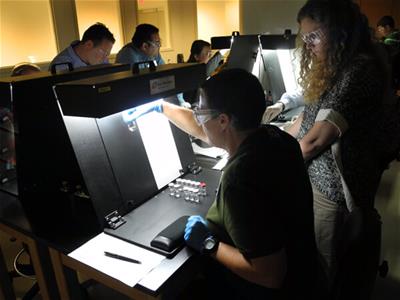Visual Inspection Training at PDA

Education is a key element of PDA’s mission and it delivers both laboratory and classroom training through the PDA Training and Research Institute (TRI) in Bethesda, Maryland. I am proud to be an instructor at TRI and have helped develop and deliver training in visual inspection of injectable products.
This training grew out of the early success of the PDA Visual Inspection Forum which began in Berlin in 2001 and continues as an annual PDA event. These meetings provide a regular venue to discuss the latest developments in visual inspection science and regulation and include the opportunity to review commercial inspection technology from vendors in the associated exhibition. The 2021 PDA Visual Inspection Forum will be offered virtually on April 14-15, 2021.
After one of the early forums, Georg Roessling, PDA, Markus Lankers, MIBIC, Jules Knapp, R&D Associates, and I discussed the possibility of developing training for visual inspection. We recognized that not everyone attending the forums was familiar with the basic science and regulation associated with this important manufacturing process, nor did many who supervise and use inspection data have any hands-on experience with it. What may look simple requires mastering several key skills to be an effective inspector. This led to the development of the Introduction to Visual Inspection course and its first offering in 2006 in Berlin immediately after the Visual Inspection Forum, and it has been held at the PDA Training and Research Institute in Bethesda ever since.
On the first day, the course covers the global regulatory requirements found in the pharmacopeias and health authorities’ guidance. Next the science of lighting and visual perception is discussed to lay the foundation for a good visual inspection program. It is important to know both why and how inspection is performed and to guide rational adaptation to the many drug formulations and packaging types. Once these are understood we move into the lab and perform manual visual inspection (MVI) of prepared standards under varying conditions to learn how critical parameters of light intensity, time, and motion effect the inspection process.
On the second day, we return to analyze individual and group inspection performance. This demonstrates how inspection metrics are used to train and qualify new inspectors and to assess the performance of an existing or new inspection process. While there is not enough time to train and fully certify a new inspector during the course, the instruction provides the necessary information to “train the trainer” to implement an effective in-house program when the student returns to their facility.
We then move deeper into specific topics of acceptance inspection, the “AQL inspection” which is performed to verify acceptable inspection performance and lot quality. We also discuss alternative inspection methods such as those performed with semi-automated (SAVI) and automated visual inspection (AVI) systems. These techniques can offer increased throughput to support larger production volume.
 We return to the lab in the afternoon of the second day to try some alternative inspection methods and practice with more challenging product examples, such as amber vials, syringes, flexible bags, and lyophilized product. We encourage student to bring many questions about their processes and products and allow plenty of time for discussion.
We return to the lab in the afternoon of the second day to try some alternative inspection methods and practice with more challenging product examples, such as amber vials, syringes, flexible bags, and lyophilized product. We encourage student to bring many questions about their processes and products and allow plenty of time for discussion.
I teach the course in Europe with Markus Lankers and in Bethesda with Ron Leversee, Perrigo and Matt Ostrowski, Pfizer. This has been a great team with a variety of experiences including particle identification and inspection department management. We listen closely to the feedback from our students and continue to update and refine the content and delivery of this course.
Student feedback led to the creation of an advanced course focused on AVI technology. Mastering AVI was developed by Romain Veillon, GSK Vaccines and has been delivered several times in Berlin with the help of Fernand Koert, GSK Vaccines and Sebastien Koch, Merck Serono. We hope to bring this course to Bethesda soon.
We have had the pleasure to teach visual inspection to over 1,000 students. They have included representatives of big and small pharmaceutical manufacturers as well as those from several of the global health authorities such as the US Food and Drug Administration (FDA), Health Canada (HC), Swiss Medic and the Health Products Regulatory Authority (HPRA) in Ireland). Some students routinely perform inspection, but many have not and all benefit from the comprehensive instruction offered. Students also come from many disciplines including Manufacturing, Quality, Engineering/Validation as well as Regulatory and Development. We teach this course multiple times each year in Bethesda and Berlin and have been able to take it “on the road” to Dublin, Tel Aviv, Sao Paolo, and Tokyo to meet the needs of the members of our global association as well as nonmembers.
Virtual VI Course
We currently find ourselves in a global pandemic which keeps us from offering in-person training. Last year we adapted the introductory course for virtual delivery. We cover the same content as the in-person training but have replaced the lab experiments with video demonstrations.
I was pleased with the level of engagement from the students. We had many good questions and were able to fully discuss the specific points of interest raised in this new virtual environment. It further opened the course to many who might not have otherwise been able to travel to attend. We will offer the course virtually again on April 12-13, 2021.
We hope to return to in-person instruction at PDA TRI in Bethesda later this year on November 9-10, 2021.
More information on these courses is available here: PDA 417.1 Introduction to Visual Inspection. We also offer a companion textbook available from the PDA Bookstore here: Visual Inspection and Particulate Control.
I hope to see you on-line or at TRI sometime soon. Keep practicing your inspection and you will find what you are looking for.



 John Shabushnig is the founder of Insight Pharma Consulting, providing expert guidance in visual inspection and particle control. He began his career with The Upjohn Company responsible for process analytical technology (PAT) and visual inspection. He was Director of Technical Support and Engineering for Pharmacia with responsibility for sterile and non-sterile technology transfer and process improvement, package engineering and automation. He later served as Director of the Center for Advanced Sterile Technology. Before starting his consulting firm, he managed microbiology and aseptic manufacturing technical support for Pfizer’s Global Quality Operations.
John Shabushnig is the founder of Insight Pharma Consulting, providing expert guidance in visual inspection and particle control. He began his career with The Upjohn Company responsible for process analytical technology (PAT) and visual inspection. He was Director of Technical Support and Engineering for Pharmacia with responsibility for sterile and non-sterile technology transfer and process improvement, package engineering and automation. He later served as Director of the Center for Advanced Sterile Technology. Before starting his consulting firm, he managed microbiology and aseptic manufacturing technical support for Pfizer’s Global Quality Operations.